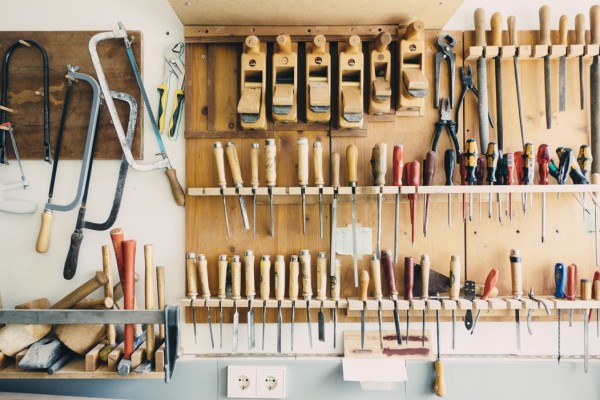
Whether fixing a leaky sink or rewiring a light switch, DIY projects can require experience. Read more for tips on keeping you and your home safe!
So, you’ve decided to take care of that leaky toilet yourself. Maybe you need to install some kitchen cabinetry. Doing repair work yourself is a fantastic way to save money while taking pride in the work you do!
Sadly, over one-third of British homeowners lack the basic DIY skills (like measuring flat-pack furniture) that were commonplace a few generations ago. With millions of homeowners running into substantial disaster each year, it’s incredibly important to go through the necessary steps to ensure your safety – and sanity. Rather than immediately call expensive professionals to do your dirty work, follow our surefire tips for DIY projects!
Do your research
With the decline of basic repair work skills in younger generations, we recommend typing a few words into Google before starting. Ask yourself, is it fairly straightforward? Is it more complicated than previously thought? Remember: a minor undertaking can do major damage should you swing a hammer or tighten a lug nut the wrong way.
If you discover that your planned project requires a zoning expert, be sure to contact the correct authorities rather than continuing with the work. They will assist you in determining the best course of action. Load-bearing walls, for example, are there for a reason. Professionals can keep you from injury and stiff government fines for conducting illegal work.
Turn off the power
We cannot stress this enough: when working with – or around – electricity, turn off the current. If you aren’t sure how to do this safely, speak with a trained professional or someone with extensive experience working with electricity.
If you’ve decided to carry out electrical work yourself, be sure that you follow the necessary electricity regulations. Drilling into an electrical line that’s buried in the wall can send you straight to the A&E! With that said, rewiring a socket or installing a light switch are simple tasks, but if you’re uncertain, call a professional.
Measure twice, cut once
The old adage rings truer than ever: with any project, don’t eyeball measurements. Be sure that everything is precise and perfect before cutting. This cuts down on extra costs associated with improperly measured materials.
Don’t rush yourself
How many times have we started a project that’s remained unfinished for months? Much of this comes down to underestimating the time it takes to complete a job. A good rule of thumb is to conduct basic internet research that gives you a better idea of time requirements, then tack on an extra 50%. Should you encounter any minor obstacles, you should still be on track for finishing on schedule.
When we rush through jobs, we make careless and dangerous mistakes. This is evidenced by the £42 million per year wasted yearly by homeowners who end up fixing their DIY bungles. Shockingly, about 30% of homeowners bring in experts to finish or rescue repairs, costing them more than if they’d hired professionals in the first place! Take your time to do things accurately.
Choose the right tools
Firstly, every homeowner should own a toolbox and understand what each instrument is used for. Next, while you’re planning your project, be sure to keep a checklist of everything that you have and everything you need to obtain. There’s nothing more deflating than setting up for a solid day of DIY projects and realising that you’re missing a desperately needed tool!
Rather than purchasing elaborate or expensive pieces of equipment that you’ll use only once, enquire with your local hardware store about the possibility of hourly or daily hiring options. While there, ask an employee to demonstrate the proper use of these instruments, and if there are any specific recommendations they have for your project. This is particularly helpful for chainsaws and other types of saws which may seem complicated at first glance. Robert from Inspire, Design & Create has a useful guide for how to find the best chainsaw online if you have a more involved project and are ready to bring home your very own equipment.
Learn how to recognise asbestos-related dangers
Around 50% of British homes built before 2000 contain asbestos, and innocent DIY projects can disturb asbestos-containing materials (ACMs). When damaged, these materials transmit airborne asbestos fibres, which are quickly inhaled. With fatal illnesses linked to construction and unprotected workers, identifying ACMs can mean the difference between life and death.
If you intend on tackling DIY projects in an older residence, it is recommended to take an asbestos awareness training course, which will instruct you on where asbestos is found, how to identify it and what to do if you encounter it in your home. Most programmes can be attended online, and provide invaluable support to their students.
When in doubt, get a second opinion
If you come across a situation that doesn’t look or feel right, immediately stop what you’re doing. With about 7% of British citizens bringing themselves into A&E each year for DIY-related injuries, there’s no reason you should become a statistic. Understanding your limitations and calling a professional is an excellent course of action.
Plan safe, stay safe
Completing DIY projects not only improves our living spaces, but it also makes us feel proud about what we’ve accomplished on our own. It’s an incredible feeling, and we hope that we’ve inspired you to tackle a project that’s been shelved too long. When you do, follow our list to make it as easy and safe as possible. Good luck!




 POSTED BY
POSTED BY 

